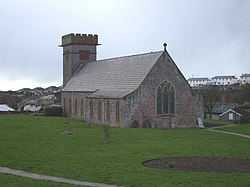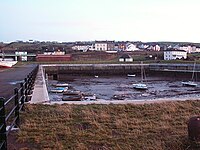Harrington, Cumberland
| Harrington | |
| Cumberland | |
|---|---|
 St Mary's parish church, Harrington | |
| Location | |
| Grid reference: | NX985255 |
| Location: | 54°36’43"N, 3°33’54"W |
| Data | |
| Population: | 2,967 (2001) |
| Post town: | Workington |
| Postcode: | CA14 |
| Dialling code: | 01946 |
| Local Government | |
| Council: | Cumberland |
| Parliamentary constituency: |
Workington |
Harrington is an old industrial village on the Irish Sea coast of Cumberland. It is to be found south of Workington and north of Whitehaven.
He industrial days of Harrington largely ended in the late 1930s, but in its time the village had an iron works, coal mining, and steel making. It once had five railway stations. It still has one station, on the coast line, the station found near the harbour.
Today, with a population of about 3,000, Harrington is largely a dormitory town for the employees of the shops and offices and light industry found in Workington and Whitehaven, and also British Nuclear Fuels down the coast at Sellafield.
The parish consists of Harrington itself, High Harrington, and Salterbeck, which is a large housing estate on the Workington side of the parish.
History
The name 'Harrington', is derived from Old English, meaning 'farmstead (or village) of Harra's clan', after an otherwise unknown local lord. Although Cumberland has many Norse place-names, this Old English form of name is commonplace along this coast, found in such places as Workington, Distington and Frizington.

Harbour
In 1760, Henry Curwen built a quay at Harrington on the south side of the River Wyre. Coal and limestone were soon being exported from Harrington, and the increase in trade led to the development of the local shipbuilding industry. A decline in manufacturing industry saw the harbour's usage drop dramatically during the latter part of the 19th century.
Eventually the harbour was sealed off and used as a reservoir for a nearby magnesium works. The secret "Magnesite" plant at Harrington was set up during Second World War by the Ministry of Aircraft Production to extract magnesium from seawater, for use in aircraft components and incendiary bombs. At the time it was one of only two plants in the country, making some 40,000 tons a year.
The harbour now has a new lease of life as a facility for leisure, with the scope to grow the marine sector in the Northwest.
Churches
Harrington had many churches, and four remain as churches today. At St Mary's church there are recent stained-glass windows, which show much of the industrial and maritime heritage of the area, including images of the latest industry - wind farming. Wind farms are springing up all along the coast, south and north of Workington.
Cycle network
The 'West Cumbria Cycle Network' passes through Harrington on its way from Distington to Workington. It uses the route of the former Cleator and Workington Junction Railway which served High Harrington Station (54°36’54"N, 3°33’3"W).